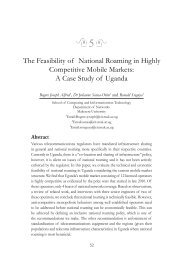Undergraduate Handbook - School of Computing and Informatics ...
Undergraduate Handbook - School of Computing and Informatics ...
Undergraduate Handbook - School of Computing and Informatics ...
You also want an ePaper? Increase the reach of your titles
YUMPU automatically turns print PDFs into web optimized ePapers that Google loves.
use <strong>of</strong> Java Base Classes, including AWT. Java foundation classes including Swing <strong>and</strong> JavaBeans will be discussed<br />
briefly, along with the selection <strong>and</strong> application <strong>of</strong> current design <strong>and</strong> development tools.<br />
Reference Books:<br />
i. J. Hubbard, Programming in C++, McGraw Hill, Schaum’s Outline Series, 2000.<br />
ii. Y. D. Liang, Introduction to Programming with C++ (Brief Version), Prentice Hall, 2007.<br />
CSC 3202: Concepts <strong>of</strong> CAD/CAM (4 CU)<br />
Course Description: Upon successful completion students will be able to: Underst<strong>and</strong> the basic concepts <strong>of</strong><br />
CAD/CAM; Demonstrate knowledge <strong>and</strong> skill in applying computer <strong>and</strong> scientific principles related to solving<br />
engineering <strong>and</strong> manufacturing problems; <strong>and</strong> develop an underst<strong>and</strong>ing <strong>of</strong> engineering design <strong>and</strong> learn how to<br />
provide technical assistance in managing CAD/CAM systems.<br />
Indicative Content: Concepts <strong>of</strong> modelling in CAD/CAM; Designing <strong>of</strong> specifications for interactive s<strong>of</strong>tware<br />
packages in grafting; Designing <strong>and</strong> manufacturing applications; Design <strong>and</strong> development <strong>of</strong> algorithms;<br />
Methodologies <strong>of</strong> problem solving in design; Role <strong>of</strong> geometric models in CAD/CAM; Techniques <strong>of</strong> displaying<br />
models using computer optimization; Concepts <strong>of</strong> data representations in CAD/CAM problems; Discussion on large<br />
numbers <strong>of</strong> case studies involving s<strong>of</strong>tware development <strong>of</strong> various problems in CAD/CAM.<br />
Reference Books:<br />
i. I. Zeid, CAD/CAM, Tata McGraw Hill, New Delhi.<br />
ii. J. Rooney & P. Steadman, Principles <strong>of</strong> Computer Aided Design, Pitman/ Open University, London.<br />
iii. J. Rooney & P. Steadman, Computer Aided Design, Pitman/Open University, London.<br />
iv. G. Mallineuse, Computational Concepts <strong>and</strong> Methods, Kogan Page Ltd. London.<br />
v. D. L. Rayan, Computer Aided Graphical Design, Marcel Dekker, New York.<br />
BSE 3204: Human-Computer Interface Design (4 CU)<br />
Course Description: The students will throughout the course: Get a thorough underst<strong>and</strong>ing <strong>of</strong> the nature <strong>of</strong> manmachine<br />
communication; Use acquired knowledge in designing user interfaces; Become familiar with the variety <strong>of</strong><br />
design <strong>and</strong> evaluation methods used in interface design; <strong>and</strong> use these methods in their projects.<br />
Indicative Content: Methods <strong>and</strong> techniques for designing user interfaces will be presented. These will include<br />
comm<strong>and</strong>-based systems, menus, graphical interfaces, desktop techniques <strong>and</strong> direct manipulation. Principles for<br />
user-friendly interfaces will be discussed using case studies from commercial Programmes (Windows, Word, DOS,<br />
UNIX, LINUX, others). Human performance: memory, perception, skill learning, task closures motivation,<br />
performance, motor skills, attention; Types <strong>of</strong> users: casual, naive, learning, expert; Collecting <strong>and</strong> evaluating<br />
behavioral data; System performance <strong>and</strong> its erect on users: response data; Styles <strong>of</strong> interaction: comm<strong>and</strong> language,<br />
form-fill, direct manipulation, hierarchical/network systems; desk-top metaphor, browsing; Help mechanisms:<br />
conventional, context sensitive, hyper text, error h<strong>and</strong>ling, implicit cues; Graphics: tools <strong>and</strong> graphical user<br />
interfaces; Dialogue design methods: dialogue principles, dialogue description languages; task analysis <strong>and</strong><br />
ergonomics.<br />
Reference Book:<br />
i. B. Shneiderman & C. Plaisant, Designing the User Interface: Strategies for Effective Human-Computer<br />
Interaction, 4th edition, Publisher: Addison Wesley.<br />
BSE 3301: Internship (4 CU)<br />
Course Description: Upon successful completion students will: Have gained work experience that allows them to<br />
sample pr<strong>of</strong>essional environments in which they might seek careers; <strong>and</strong> have experience that will help prepare them<br />
for careers <strong>and</strong> research.<br />
120

















